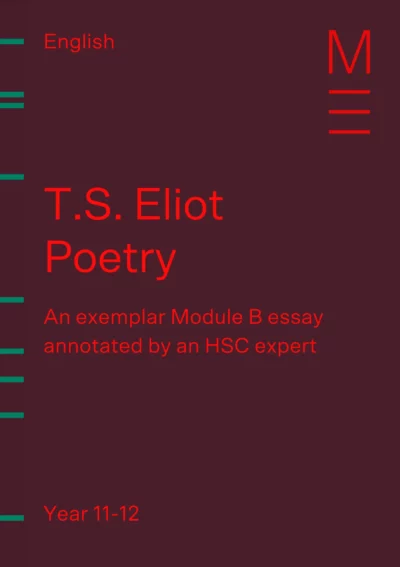Welcome to Matrix Education
To ensure we are showing you the most relevant content, please select your location below.
Select a year to see courses
Learn online or on-campus during the term or school holidays
Learn online or on-campus during the term or school holidays
Learn online or on-campus during the term or school holidays
Learn online or on-campus during the term or school holidays
Learn online or on-campus during the term or school holidays
Learn online or on-campus during the term or school holidays
Learn online or on-campus during the term or school holidays
Get HSC Trial exam ready in just a week
Get HSC exam ready in just a week
Select a year to see available courses
Science guides to help you get ahead
Science guides to help you get ahead
Learn how to tackle Eliot's poetry for Module B with our comprehensive two part study guide.

Guide Chapters
Join 75,893 students who already have a head start.
"*" indicates required fields

Join 8000+ students each term who already have a head start on their school academic journey.
In this article, we are going to look at what a Module B essay requires before moving on to some preliminary themes in Eliot’s poems.
The Module B essay has a terrifying reputation. In the HSC, the questions are notoriously specific, meaning that it is difficult to simply use a prepared essay. It is no wonder that many students find it the most overwhelming of the modules. Not only are its demands esoteric in comparison to the other modules, but you also have to study prickly texts.
In reality, a module B essay’s requirements are not that much different to the other modules. And panicking and fretting over things only leads to muddled responses, or a failure to write at all. Heaped onto the textual analysis and consideration of context found in other modules, Mod B has the added considerations of canonical status, textual integrity, and critical perspectives. The question I am asked most frequently by students each year is “Pat, what’s textual integrity?” NESA doesn’t explain it clearly at all, but understanding and discussing it is essential to getting a Band 6.
Want to read an exemplary TS Eliot essay?
See exactly why HSC markers would score this essay highly! Fill out your details below to get this resource emailed to you. "*" indicates required fields
Download your annotated Module B: T.S. Eliot essay

Download your annotated Module B: T.S. Eliot essay
Looking for part 2? Read the next part of this study guide: HSC English Module B Study Guide: T.S. Eliot Part 2 [Free Textual Analysis]
What you need to do to achieve a Band 6 mark is to present a well-structured response that demonstrates how the textual integrity of the selection of Eliot’s poetry establishes its canonical status. To do this, your essay must demonstrate how a selection of themes from the text, coupled with form, create a unified whole that has a lasting value or significance.
But what is textual integrity?
NESA is vague on this. The syllabus definition is:
“The unity of a text; its coherent use of form and language to produce an integrated whole in terms of meaning and value.”
What does this actually mean? Well, this is a convoluted way of saying that the text has coherence: a unity of ideas and form. For example, if you pretended to be a poet struggling to show a dysfunctional and unhealthy society, you might choose to use a lot of enjambment and slant rhyme to represent this dysfunction structurally.
Eliot actually does this; an example can be found in stanza two of Preludes(1911):
Eliot T.S, Preludes. (1911)
The morning comes to consciousness
Of faint stale smells of beer
From the sawdust-trampled street
With all its muddy feet that press
To early coffee-stands.
In this stanza, the persona is presenting the workers’ daily struggle. The workers wake up hungover from too much booze the night before, and they need coffee to struggle through the day. The persona perceives that the workers are trapped in a horrible and unnatural routine: they drink to forget their woes at night, and suffer the consequences the next morning. This is represented in the broken flow of the lines: all except the final line are enjambed. The enjambment breaks the continuity of the lines; they seem to flow on the page but are fragmented when spoken.
The rhyme is unnatural, too. ‘Consciousness’ seems to rhyme with ‘press’, but the rhyme is only partially there – it sounds funny and not quite right. This is called a slant, or half, rhyme. Taken together, these are examples of the text’s textual integrity. We can argue that these combine to “present an integrated whole in terms of meaning and value.”
You can also discuss textual integrity in terms of the thematic cohesion of Eliot’s corpus. Eliot consistently critiques modernity, the corruption caused by liberalism, and the individual’s struggle against diffidence and loneliness. Or if that doesn’t interest you, you can consider his use of intertextuality and form to convey and reinforce meaning. These are present in Eliot’s interpolation of folk songs (such as in Prufrock and Hollow Men) and classical literature (in all of the poems) in his work or the mastery of different forms he demonstrates in his poems.
If you are still unsure what textual integrity is, you must read our Essential Guide to Textual Integrity.
The other thing you need to discuss is the text’s canonical status.
A text can attain canonical status because of its use of form. Perhaps it is considered ground-breaking in its use of the sonnet form, or it is lauded as being the best example of a ballad. Some texts gain their canonical status because they do all of these things. You need to decide and discuss if Eliot’s poetry fits these descriptions. For a text to have lasting value, it has to be widely lauded and have appeal to audiences over a range of periods. A text’s appeal to a range of audiences can lie in its thematic relevance to audiences. You need to figure out if it is speaking to, or perhaps challenging, a society’s values over time.
Canonical texts engage with universal human concerns such as the human condition (the affliction of being human – traumatic, I know!) often these are presented through big existential question like “what is the meaning of life” or “is there a god.” Or these concerns are personal ones such as “why do I procrastinate,” “why is life a struggle” or “why am I an outsider.”
To decide a text’s canonical status you want to ask yourself questions like:
If you would like to learn more about critical reception, read our post on Understanding Module B: Critical Reception, Context, and Significance.
Start HSC English confidently
Expert teachers, detailed feedback, one-to-one help! Learn from home with Matrix+ Online English courses.
An important aspect of canonical status is a text’s use of themes. If these themes are universal, then the text has a universal relevance. This will contribute to the text’s place in the canon. So what themes are there in the set poems? Let’s have a look:
| Relationships | The characters in Eliot’s poetry struggle with their relationships with others. They fail to connect properly, or have failed relationships because of their competing expectations. |
| Modernity | Eliot, like other modernists, is critical of the modern world and its rapidly changing values. |
| Isolation | The modern world isolates individuals from society with its competing demands of labour and social expectation.Now let’s define these ideas so you can use them to structure your responses: |
| Gender | Eliot wrestles with the changing gender roles in 20th century society. He is titillated by sexual freedom, but disgusted at the same time. His male characters struggle with their masculinity. |
| Literary tradition | Eliot is deeply concerned with literary tradition and its place in the modern world. His poems are packed with references to other literature. |
| Time | Modernists were obsessed with time. Time is experienced subjectively; it seems to pass at different speeds at different times. Individuals feel they have all the time in the world only to discover that time has passed too quickly. |
| Entropy and decay | Entropy is the idea that all things decay and break down. Modernists perceived the structures as the world and human relationships being affected by entropy, too. |
| Personal struggle | Individuals in Eliot’s poems struggle with their own identity and place in society. The changes of the modern world have left their lives full of uncertainty. |
| Cycles | The poet WB Yeats had developed a focus on the cyclical nature of history. Other modernists, such as Eliot, adopted this. Modernists perceived, and represented, history as being prone to the repetition of the same mistakes. |
| Faith | Eliot struggled with faith. He converted to Anglican Catholicism at a late age. He then struggled with this belief and wrote about it at length. Meanwhile, the modern world was becoming increasingly secular. |
| Mental health | Modernism coincided with the development of psychoanalysis and psychiatry. The individual’s psychic struggle with existence in the modern world became even more fraught with the trauma of World War One. |
| Tradition | Modernity brought changes to labour roles, habitation, gender, class, religion, and social structure. These were often resisted by conservatives who lamented the loss of the old ways. |
| Death | Death is universal. Everybody dies. Eliot wrote extensively about the effects of coming to terms with one’s mortality. |
| The quest | Eliot’s poems often discuss quests. Traditionally the quest narrative was the search for a holy relic or special object, but in Eliot’s work this object could be understanding or faith.Once you understand your themes, you need to gather evidence that you can use to support your arguments about them. In Part 2, we will look at some examples for a couple of these ideas for you to use in essays. |
Written by Matrix English Team
The Matrix English Team are tutors and teachers with a passion for English and a dedication to seeing Matrix Students achieving their academic goals.© Matrix Education and www.matrix.edu.au, 2025. Unauthorised use and/or duplication of this material without express and written permission from this site’s author and/or owner is strictly prohibited. Excerpts and links may be used, provided that full and clear credit is given to Matrix Education and www.matrix.edu.au with appropriate and specific direction to the original content.